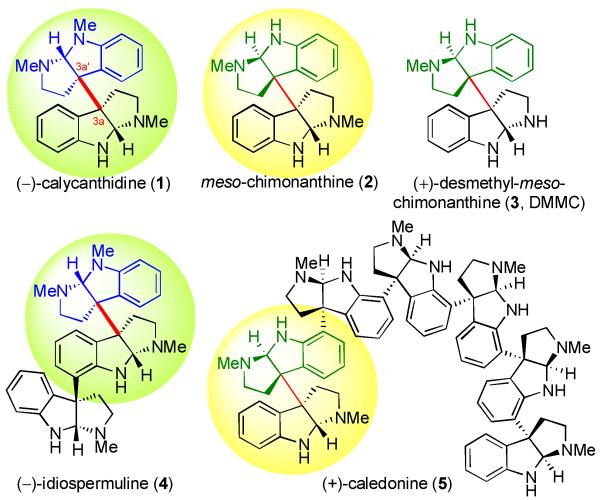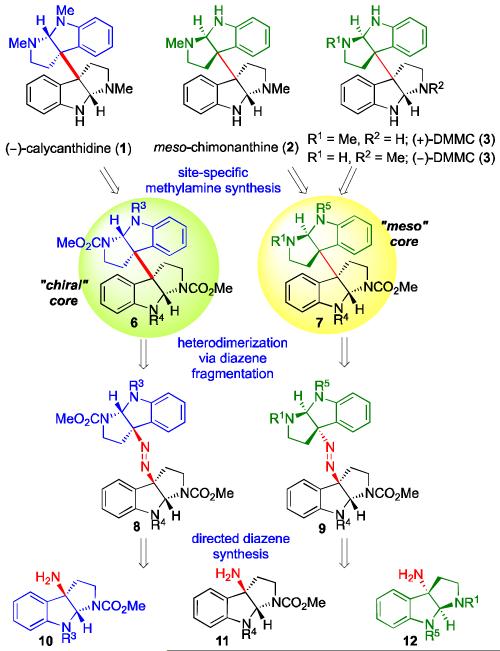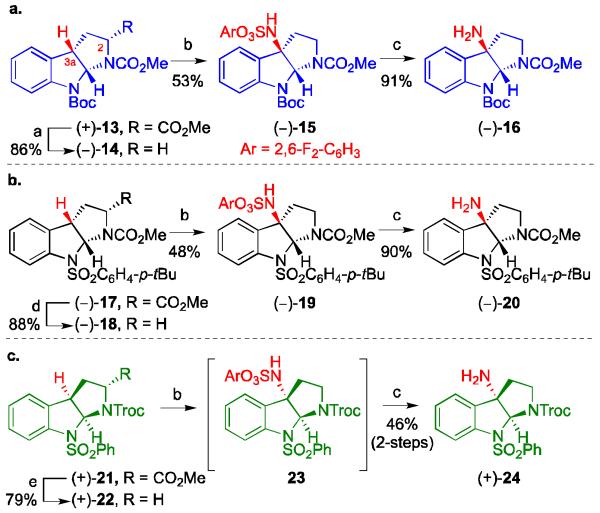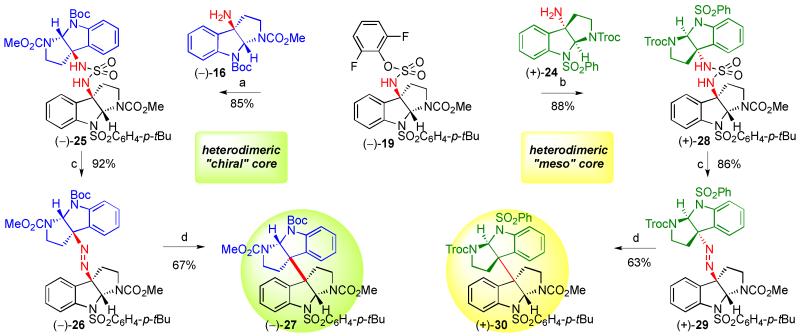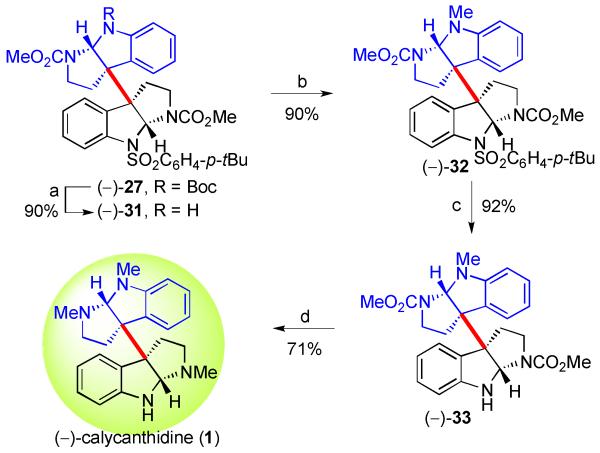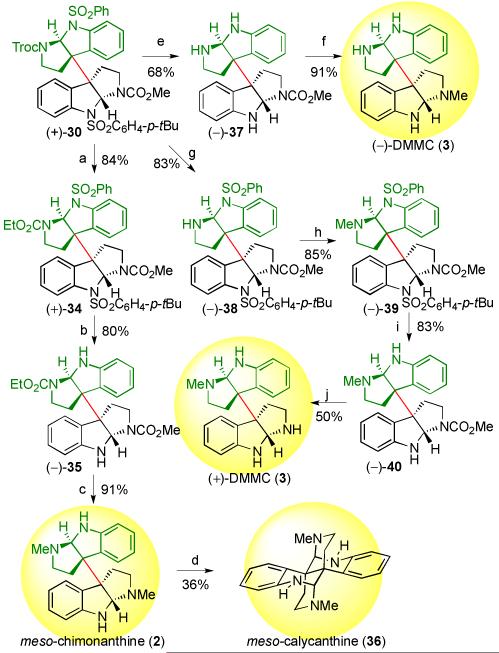Abstract
We describe the first application of our methodology for heterodimerization via diazene fragmentation towards the total synthesis of (−)-calycanthidine, meso-chimonanthine, and (+)-desmethyl-meso-chimonanthine. Our syntheses of these alkaloids feature an improved route to C3a-aminocyclotryptamines, an enhanced method for sulfamide synthesis and oxidation, in addition to a late-stage diversification leading to the first enantioselective total synthesis of (+)-desmethyl-meso-chimonanthine and its unambiguous stereochemical assignment. This versatile strategy for directed assembly of heterodimeric cyclotryptamine alkaloids has broad implications for the controlled synthesis of higher order derivatives with related substructures.
Introduction
Alkaloids comprising multiple cyclotryptamine units adjoined at C3a and C7 junctures constitute a large family of structurally fascinating natural products, which display a wide range of biological activities1 and possess retrosynthetically challenging and sterically crowded quaternary linkages. Moreover, in certain cases the synthetic challenge is exacerbated by the heterodimeric C3a–C3a’ connectivity (Figure 1). Significant advances have been made in the assembly of Csp2–Csp3,2,3 Csp3–Csp3,4,5,6 and N–Csp3 7 linkages in cyclotryptamine based alkaloids. Recently, we reported a general strategy for the selective late stage C–C bond construction at the C3a quaternary stereocenters of two dissimilar cyclotryptamine subunits.5e Herein, we report the first application of our diazene5e,8 based heterodimerization strategy for the total synthesis of (−)-calycanthidine (1),9 meso-chimonanthine (2),10 and (+)-desmethyl-meso-chimonanthine (DMMC, 3), an alkaloid with previously undefined stereochemistry.11 We sought a unified approach for the selective synthesis of these three natural products as a critical demonstration of the broader applicability of our diazene-based fragment-coupling chemistry for the synthesis of more complex natural products such as (−)-idiospermuline (4)12 and (+)-caledonine (5).11 Our syntheses feature an improved route to C3a-aminocyclotryptamines, an enhanced method for sulfamide synthesis and oxidation, in addition to late-stage diversification allowing access to both enantiomers of DMMC (3) from a single heterodimeric intermediate, resulting in the first enantioselective total synthesis of (+)-(3) and its unambiguous stereochemical assignment.
Figure 1.
Representative cyclotryptamine based natural products.
The dimeric, heterodimeric, and oligomeric cyclotryptamine alkaloids have been found to possess an assortment of impressive biological activities, ranging from analgesic, antiviral, antifungal, antibacterial to cytotoxicity against human cancer cell lines.11,13 (−)-Calycanthidine (1) was originally isolated in 1938 from Calycanthus floridus,9 with the structure being fully elucidated in 1962.14 Overman and co-workers’ concise enantioselective synthesis of (−)-1 via diastereoselective dialkylation allowed for the assignment of its absolute stereochemistry.2a,b Meso-chimonanthine (2), originally isolated in 1961 from chimonathus fragrans10a but not fully identified as a natural isolate until 1964,4d has been synthesized previously via the unselective oxidative dimerization of tryptamine derivatives.2g,4a,c-f,m-o Overman and co-workers have reported the selective synthesis of meso-chimonanthine (2) via a reductive dialkylation or a double Heck cyclization to secure the vicinal quaternary stereocenters.4i,k,l (+)-Desmethyl-meso-chimonanthine (3) was initially isolated in 1999 from the Rubiaceae Psychotria lyciiflora.11,15 However, the absolute stereochemistry was not assigned in the isolation report.
Retrosynthetic Analysis
A central objective of our retrosynthetic approach to (−)-calycanthidine (1), meso-chimonanthine (2), (+)- and (−)-desmethyl-meso-chimonanthine (DMMC, 3) was to establish a general strategy reliant on the late-stage directed assembly of versatile precursors with potential for application to more complex cyclotryptamine containing alkaloids. We envisioned accessing these four alkaloids from only two heterodimers 6 and 7 that would in turn be prepared from enantiomerically enriched C3a-aminocyclotryptamines 10–12 (Scheme 1). Whereas site specific methyl amine synthesis on the “chiral”-heterodimer 6 would allow access to (−)-calycanthidine (1), a similar strategic introduction of methyl units onto “meso”-heterodimer 7 would readily afford meso-chimonanthine (2) as well as both enantiomers of DMMC (3). The vicinal quaternary stereocenters bearing the C3a–C3a’ linkage of the key heterodimers 6 and 7 would be secured from diazenes 8 and 9, respectively, via implementation of our diazene-directed heterodimerization strategy using C3a-aminocyclotryptamines 10–12.5e,16 Owing to our knowledge of the relatively weak nature of the benzylic C3a–H bond of related cyclotryptamines,1c,5a,e we saw an opportunity for examination of the latest advances in intermolecular C–H amination for the synthesis of amines 10–12.17 We envision that the optimization and implementation of our planned strategy for the total synthesis of these heterodimeric cyclotryptamine natural products will serve as the foundation for further application to related complex natural products.
Scheme 1.
Retrosynthetic analysis of (−)-calycanthidine (1), meso-chimonanthine (2), (+)- and (−)-desmethyl-meso-chimonanthine (3, DMMC).
Synthesis of C3a-aminocyclotryptamines via catalytic intermolecular C–H amination
Given the importance of the C3a-aminocyclotryptamines 10–12 to the success of our planned synthesis we sought improved methods to access the desired amines.5e,18 With this in mind we turned our attention to rhodium-catalyzed C–H amination for the introduction of the required C3a-amine functional group. Based on our previous success in selective benzylic bromination of similar C3a–H cyclotryptamines,5a,e we hypothesized that the benzylic C3a–H would serve as an ideal substrate for rhodium-catalyzed C–H amination.19,20,21 Moreover, we believed that the resulting sulfamate ester obtained from the C–H amination might provide an opportunity for rapid synthesis of the desired mixed sulfamides by removing the need to prepare the more sensitive sulfamoyl chlorides22 used in our previous report.5e Indeed, as a separate part of our studies directed at efficient synthesis of diazenes, 2-hydroxyphenyl23 and 4-nitrophenyl24 sulfamate esters had proven effective coupling partners for entry to various sulfamide derivatives.25 In order to test these hypotheses cyclotryptamine (−)-14 was synthesized from the cyclotryptophan derivative (+)-13 in 86% yield via hydrolysis of the ester, Barton ester formation, and subsequent photodecarboxylation (Scheme 2a).26
Scheme 2.
C–H Amination, synthesis of amines (−)-16, (−)-20 and (+)-24. Conditions: (a) i) 5 N KOH (aq), MeOH, 23 °C; ii) TCFH, thiopyridine N-oxide, DMAP, Et3N, THF, then t-BuSH, hν;, 23 °C, 86%; (b) Rh2(esp)2, H2NSO3Ar, PhI(OAc)2, Ph(CH3)2CCO2H, MgO, 5 Å MS, i-PrOAc, 23 °C, for 14→15, 53%, 18→19, 48%; (c) pyridine, MeCN, H2O, 70 °C, for 15→16, 91%, 19→20, 90%, 22→24, 46% (2 steps); (d) i) 5 N KOH (aq), MeOH, 23 °C; ii) (COCl)2, DMF, CH2Cl2, 23 °C; iii) (Me3Si)3SiH, AIBN, PhMe, 80 °C, 88%; (e) i) Me3SnOH, DCE, 80 °C; ii) TCFH, thiopyridine N-oxide, DMAP, Et3N, THF, then t-BuSH, hν, 23 °C (79%, 2 steps); DMF = dimethylformamide, AIBN = azobisisobutyronitrile, TCFH = N,N,N-’,N’-tetramethylchloroformamidinium hexafluorophosphate, DMAP = 4-(dimethylamino)pyridine, THF = tetrahydrofuran, DCE = 1,2-dichloroethane.
With cyclotryptamine (−)-14 in hand we were poised to examine the desired C–H amination. Utilizing the latest conditions and reagents generously provided to us by Du Bois and coworkers for selective intermolecular tertiary C–H amination19,27 we were able to obtain the desired arylsulfamate ester (−)-15 in 53% yield. Interestingly, we observed the undesired C–H amination at C2 to be the major byproduct of the rhodium catalyzed C–H amination reaction (10–15%).28,29 We postulate that the increased steric demands of the C3a–H cyclotryptamine (−)-14 lead to the observed competitive C2 amination.30 Hydrolysis of the sulfamate ester (−)-15 efficiently gave the desired C3a amine (−)-16 in 91% yield. The differentially functionalized C3a-aminocyclotryptamine (−)-20 was synthesized in an analogous fashion from the tricycle (−)-17 in 38% yield over 4 steps (Scheme 2b).31 We subsequently discovered that the desired amine (+)-24 could be directly obtained from the corresponding cyclotryptamine in a two-step sequence without purification of the sulfamate ester. In the event, rhodium-catalyzed C–H amination of cyclotryptamine (+)-22 followed by treatment of the crude sulfamate ester 23 with pyridine in acetonitrile–water mixture at 70 °C directly afforded the C3a-aminocyclotryptamine (+)-24 in 46% yield over two-steps (Scheme 2c).
The application of selective C–H amination allows for direct access to the desired C3a-aminocyclotrytamine in only two steps from the corresponding C3a–H cyclotryptamines, eliminates the need for preparation of azides, and precludes the requirement for prior activation as the benzylic bromide.5e Furthermore, access to sulfamate ester (−)-19 has allowed examination of its use as a coupling partner in place of our previously utilized sulfamoyl chlorides for the synthesis of mixed sulfamides (vide infra).
Sulfamide formation, oxidation and diazene fragmentation
With the desired amines in hand we were ready to access the heterodimers (−)-27 and (+)-30 via directed sulfamide formation, mild oxidation, and localized diazene fragmentation (Scheme 3). In our previous report, we carried out sulfamide formation by first selectively converting one of the amines to the sulfamoyl chloride followed by treatment with the other amine to afford the desired mixed sulfamide.5e We hypothesized that arylsulfamate (−)-19, the direct product of C–H amination, could be utilized in place of the sulfamoyl chloride. We were delighted to find that exposure of sulfamate ester (−)-19 to amine (−)-16 in the presence of triethylamine in tetrahydrofuran afforded the desired sulfamide (−)-25 in 85% yield. Notably, only a slight excess (1.2 equiv) of sulfamate (−)-19 is required to efficiently obtain the desired product despite the severe steric constraints inherent in these systems. This represents a significant streamlining of sulfamide synthesis as the heterodimeric sulfamide can now be directly generated from the C–H amination product without need for formation of the more sensitive sulfamoyl chloride. We expect that this process should provide a general route to a wide range of sulfamide derivatives and the corresponding diazenes.
Scheme 3.
Synthesis of heterodimers (−)-27 and (+)-30 via diazene fragmentation. Conditions: (a) Et3N, (−)-16, THF, 23 °C, 85%; (b) Et3N, (+)-24, THF, 23 °C, 88%; (c) 1,3-dichloro-5,5-dimethylhydantoin, DBU, MeOH, 23 °C, for 25→26, 92%, 28→29, 86%; (d) hν (380 nm), 23 °C, for 26→27, 67%, 29→30, 63%; DBU = 1,8-diazabicyclo[5.4.0]undec-7-ene.
Next, oxidation of sulfamide (−)-25 to the diazene was required.32 Our previous conditions for oxidation necessitated a large excess of oxidant and base to ensure complete conversion to the desired diazene.5e Upon further optimization of the reaction conditions we found that protic solvents gave high yields of the desired product while requiring fewer equivalents of both base and oxidant. Notably, more electrophilic chlorinating agent 1,3-dichloro-5,5-dimethylhydantoin (DCDMH) proved ideal. Under our new and optimized conditions, treatment of sulfamide (−)-25 with 1,8-diazabicyclo[5.4.0]undec-7-ene (DBU, 5 equiv) and DCDMH (2.5 equiv) in methanol provided the diazene (−)-26 in 92% isolated yield. Most likely, the alcoholic solvent increases the rate of proton transfer, leading to an increase in the rate of oxidation of the sulfamide nitrogen and therefore decreases the undesired consumption of the oxidant by the amine base.
Initially, we sought to exploit the solvent-cage effect we observed previously by conducting the photolysis of unsymmetrical diazene (−)-26 in tert-butanol.5e However, diazene (−)-26 was found to be sparingly soluble in tert-butanol. Therefore, we explored conducting the photolysis in the solid state with the hope of increasing the localization effect and favoring the heterodimerization33 while being cognizant that an increase in the formation of disproportionation products was concievable.33a,b We found that photolysis of the diazene (−)-26 as a thin film in the absence of solvent afforded the “chiral” heterodimer (−)-27 in 67% yield with minimal formation of disproportionation products and the absence of related cross-over products.
Applying a similar strategy we were able to access the desired “meso” heterodimer (+)-30. Treatment of the sulfamate ester (−)-19 with triethylamine in the presence of tricyclic amine (+)-24 afforded the new mixed sulfamide (+)-28 in 88% yield. Subsequent oxidation under our newly optimized conditions for diazene formation provided the unsymmetrical diazene (+)-29 in 86% yield. Photolysis of (+)-29 as a thin film selectively provided the “meso” heterodimer (+)-30 in 63% yield without any detectable cross-over products. Importantly, the application of our diazene based strategy for heterodimer assembly has allowed the rapid and selective synthesis of two strategically functional heterodimers [(−)-27 and (+)-30] for selective late stage methylamine synthesis, from two distinct amines [(−)-16 and (+)-24] and a single versatile sulfamate ester (19).
Total syntheses of (−)-calycanthidine (1), meso-chimonanthine (2), (+)- and (−)-desmethyl-meso-chimonanthine (3)
With access to both desired heterodimers we were poised to access (−)-calycanthidine (1, Scheme 4) via selective functionalization of “chiral” heterodimer (−)-27. Treatment of heterodimer 27 with trifluoroacetic acid selectively removed the tert-butyl carbamate (90% yield), allowing the ensuing reductive methylation of the resultant indoline (−)-31 to afford the desired N-methyl indoline (−)-32 in 90% yield. Exposure of (−)-32 to sodium amalgam in methanol, followed by reduction of the methylcarbamate functional groupings of indoline (−)-33 provided synthetic (−)-calycanthidine (1) in 65% yield over the final two steps. All 1H and 13C NMR data as well as the optical rotation (observed [α]24D = −289.6, c = 1.54, MeOH; literature [α]20 = −285.1, c = 1.992, MeOH) for synthetic (−)-1 were in agreement with literature data.2a,b, 9
Scheme 4.
Total synthesis of (−)-calycanthidine (1). Conditions: (a) CH2Cl2, TFA, 90%; (b) formalin, NaBH3CN, AcOH, MeCN, 23 °C, 90%; (c) Na(Hg), NaH2PO4, MeOH, 23 °C, 92%; (d) Red-Al, PhMe, 110 °C, 71%; TFA = trifluoroacetic acid, Red-Al = sodium bis(2-methoxyethoxy)aluminium hydride.
Having successfully employed “chiral” heterodimer (−)-27 enroute to (−)-calycanthidine (1) we hoped to exploit a similar strategy utilizing the “meso” heterodimer (+)-30 for the synthesis of meso-chimonanthine (2, Scheme 5) in addition to (+)-DMMC (3) and (−)-DMMC (3). While attempts to reduce both carbamate functional groupings of heterodimer (+)-30 to the corresponding methyl amines resulted in removal of the trichloroethyl carbamate, treatment of heterodimer (+)-30 with lithium triethylborohydride led exclusively to the formation of ethyl carbamate (+)-34 in 84% yield.34 Although unexpected, the formation of intermediate (+)-34 proved critically beneficial as it permitted selective removal of the arenesulfonyl groups to afford the free indoline (−)-35 in 80% yield. A final reduction of the two carbamate functional groupings selectively gave meso-chimonanthine (2) in 91% yield. All 1H and 13C NMR data for our synthetic 2 were identical in all respects to the literature values for meso-chimonanthine (2).4 Intrigued by the presence of related reorganized natural products in the chiral chimonanthine series,4k,5a,35 we investigated the rearrangement of meso-chimonanthine (2) to the corresponding meso-calycanthine (36, Scheme 5). In the event, the acid mediated rearrangement of meso-chimonanthine (2) was explored by heating a solution of 2 in deuterium oxide and acetic acid-d6 to 95 °C and the progress monitored by in situ 1H NMR.36 After 24 h, >90% consumption of meso-chimonanthine was observed, affording a mixture of meso-calycanthine (36) as well as products related to fragmentation of the fragile C3a-C3a’ bond. Subsequent basic work-up and purification by flash column chromatography provided meso-calycanthine (36) in 36% yield. Resubmission of isolated meso-calycanthine (36) to the acidic conditions resulted in no change, suggesting that in contrast to the equilibrium observed between chimonanthine and calycanthine (15:85),5a the thermodynamic equilibrium between 2 and 36 strongly favors meso-calycanthine (36).
Scheme 5.
Total synthesis of meso-chimonanthine (2) and (+)- and (−)-desmethyl-meso-chimonanthine (DMMC, 3). Conditions: (a) LiEt3BH, THF, 65 °C, 84%; (b) Na(Hg), NaH2PO4, MeOH, 23 °C, 80%; (c) Red-Al, PhMe, 110 °C, 91%; (d) D2O, CD3CO2D, 95 °C, 24 h, 36%; (e) Na(Hg), NaH2PO4, MeOH, 23 °C, 68%; (f) Red-Al, PhMe, 110 °C, 91%; (g) Zn, AcOH, MeOH, 23 °C, 83%; (h) formalin, NaCNBH3, AcOH, MeCN, 23 °C, 85%; (i) Na(Hg), NaH2PO4, MeOH, 23 °C, 83%; (j) 5 N NaOH (aq), MeOH, 65 °C, 50%.
We next turned our focus to the synthesis and assignment of absolute stereochemistry of (+)-DMMC (3) from the same versatile “meso” heterodimer (+)-30. Our ability to unequivocally assign the absolute stereochemistry of (+)-DMMC (3) centered on our capacity to access both enantiomers of this previously unassigned natural alkaloid. We found exposure of heterodimer (+)-30 to sodium amalgam in methanol resulted in removal of the trichloroethyl carbamate along with the sulfonyl groups in a single step to afford triamine (−)-37 in 68% yield (Scheme 5). Subsequent reduction of the methyl carbamate with Red-Al afforded the desired methyl amine 3 in 91% yield. All 1H and 13C NMR data for synthetic 3 were identical in all respects to the literature values for (+)-DMMC (3).11 However, the observed optical rotation of our synthetic 3 was opposite in sign to that of the natural product (observed [α]24D = −1.8, c = 0.20, EtOH; literature [α]25D = +0.5, c = 1, EtOH)11 and therefore we assigned the depicted structure as (−)-DMMC (3). Importantly, careful and repeated analysis of the same sample over 2 h indicated a steady decrease in the magnitude of the observed rotation with eventual inversion of the sign. Both 1H NMR and TLC analysis of the sample indicated minor decomposition (<5%) of the natural product during this process, which is likely responsible for the gradual drift of the optical rotation value.37 We hypothesize that this observed variation in optical rotation over time is responsible for the discrepancy in the absolute value of the optical rotation of our sample and that of the natural isolate.11 Nevertheless, we are fully confident in the high quality of our sample, its optical rotation, and its absolute stereochemistry as depicted in Scheme 5.
To further clarify the absolute stereochemistry of (+)- and (−)-DMMC (3), and to confirm our observations regarding sample sensitivity as described above, we sought to access (+)-DMMC (3) by exploiting the versatility of the “meso” heterodimer (+)-30 (Scheme 5). Enantioselective total synthesis of both (+)- and (−)-DMMC (3) from heterodimer (+)-30, would allow unambiguous confirmation of the absolute stereochemistry of DMMC (3) and also highlight the utility of heterodimer (+)-30 as a synthetic intermediate for preparation of these cyclotryptamine alkaloids. Selective trichloroethyl carbamate removal with zinc in a mixture of acetic acid and methanol provided the free amine (−)-38 in 83% yield. Subsequent reductive methylation with formalin and sodium cyanoborohydride (85% yield), followed by removal of the arenesulfonyl groupings to afford the free indoline (−)-40 (83% yield) and hydrolysis of the methyl carbamate provided the first synthetic sample of (+)-DMMC (3).11 All 1H and13C NMR data for synthetic 3 were identical to the literature values for (+)-DMMC (3) and the optical rotation of our synthetic (+)-3 was consistent with that reported in the literature (observed [α]24D = +2.7, c = 0.13 EtOH). Importantly, the same observations regarding the critical purity of the sample in optical activity determination were observed once again. Having accessed both enantiomers of the natural product from known chiral feedstock we can confidently assign the absolute configuration of (+)- and (−)-desmethyl-meso-chimonanthine (3) as shown in Scheme 5.38
Conclusions
Application of our diazene based method for heterodimerization has allowed the total syntheses of (−)-calycanthidine (1), meso-chimonanthine (2), (+)- and (−)-desmethyl-meso-chimonanthine (3). Our synthetic route takes advantage of the inherent symmetry found in this group of natural products and allows us to selectively access these four unique compounds from only two distinct heterodimers (27 and 30), two unique amines (16 and 24) and the sulfamate (19). Furthermore, access to (+)- and (−)-desmethyl-meso-chimonanthine (3) has allowed for its unambiguous stereochemical assignment. The successful implementation of our diazene-based heterodimerization for the synthesis of the three heterodimeric cyclotryptamine alkaloids will serve as the foundation for further application to the controlled synthesis of more complex cyclotryptamine-containing natural products such as (−)-idiospermuline (4) and (+)-caledonine (5).
Supplementary Material
Acknowledgements
We acknowledge financial support by NIH-NIGMS (GM089732). S. P. L. is grateful to the a NIH for a Ruth L. Kirschstein NRSA postdoctoral fellowship (F32GM097776). We acknowledge the NSF under CCI Center for selective C–H functionalization (CHE-1205646) for support related to C–H amination chemistry. We are grateful for advice, catalysts, and reagents provided by professors J. Du Bois, H. M. L. Davies, H. Lebel, and J. L. Roizen.
Footnotes
Electronic Supplementary Information (ESI) available: Details for all biological assays as well as experimental procedures, spectroscopic data, and copies of 1H, 13C, and 19F NMR spectra. See DOI: 10.1039/b000000x/
Notes and references
- 1.(a) Cordell GA, Saxton JE. In: The Alkaloids: Chemistry and Physiology. Manske RHF, Rodrigo RGA, editors. Vol. 20. Academic Press; New York: 1981. pp. 3–294. [Google Scholar]; (b) Hino T, Nakagawa M. In: The Alkaloids: Chemistry and Pharmacology. Brossi A, editor. Vol. 34. Academic Press; New York: 1989. pp. 1–75. [Google Scholar]; (c) Crich D, Banerjee A. Acc. Chem. Res. 2007;40:151. doi: 10.1021/ar050175j. [DOI] [PubMed] [Google Scholar]; (d) Steven A, Overman LE. Angew. Chem., Int. Ed. 2007;46:5488. doi: 10.1002/anie.200700612. [DOI] [PubMed] [Google Scholar]
- 2.(a) Overman LE, Peterson EA. Angew. Chem., Int. Ed. 2003;42:2525. doi: 10.1002/anie.200351260. [DOI] [PubMed] [Google Scholar]; (b) Overman LE, Peterson EA. Tetrahedron. 2003;59:6905. [Google Scholar]; (c) Govek SP, Overman LE. Tetrahedron. 2007;63:8499. [Google Scholar]; (d) Overman LE, Shin Y. Org. Lett. 2007;9:339. doi: 10.1021/ol062801y. [DOI] [PMC free article] [PubMed] [Google Scholar]; (e) Kodanko JJ, Hiebert S, Peterson EA, Sung L, Overman LE, de Moura Linck V, Goerck GC, Amador TA, Leal MB, Elisabetsky E. J. Org. Chem. 2007;72:7909. doi: 10.1021/jo7013643. [DOI] [PubMed] [Google Scholar]; (f) Schammel AW, Boal BW, Zu L, Mesganaw T, Garg NK. Tetrahedron. 2010;66:4687. doi: 10.1016/j.tet.2010.02.050. [DOI] [PMC free article] [PubMed] [Google Scholar]; (g) Snell RH, Woodward RL, Willis MC. Angew. Chem., Int. Ed. 2011;50:9116. doi: 10.1002/anie.201103864. [DOI] [PubMed] [Google Scholar]; (h) DeLorbe JE, Jabri SY, Mennen SM, Overman LE, Zhang F-L. J. Am. Chem. Soc. 2011;133:6549. doi: 10.1021/ja201789v. [DOI] [PMC free article] [PubMed] [Google Scholar]; (i) Furst L, Narayanam JMR, Sephenson CRJ. Angew. Chem., Int. Ed. 2011;50:9655. doi: 10.1002/anie.201103145. [DOI] [PMC free article] [PubMed] [Google Scholar]; (k) Kieffer ME, Chuang KV, Reisman SE. J. Am. Chem. Soc. 2013;135:5557. doi: 10.1021/ja4023557. [DOI] [PMC free article] [PubMed] [Google Scholar]
- 3.(a) Kim J, Movassaghi M. J. Am. Chem. Soc. 2011;133:14940. doi: 10.1021/ja206743v. [DOI] [PMC free article] [PubMed] [Google Scholar]; (b) Boyer N, Movassaghi M. Chem. Sci. 2012;3:1798. doi: 10.1039/C2SC20270K. [DOI] [PMC free article] [PubMed] [Google Scholar]; (c) Coste A, Kim J, Adams TC, Movassaghi M. Chem. Sci. 2013;4:3191. doi: 10.1039/C3SC51150B. [DOI] [PMC free article] [PubMed] [Google Scholar]
- 4.(a) Hendrickson JB, Rees R, Göschke R. Proc. Chem. Soc. 1962:383. [Google Scholar]; (b) Hino T, Yamada S-I. Tetrahedron Lett. 1963;4:1757. [Google Scholar]; (c) Hendrickson JB, Göschke R, Rees R. Tetrahedron. 1964;20:565. [Google Scholar]; (d) Scott AI, McCapra F, Hall ES. J. Am. Chem. Soc. 1964;86:302. doi: 10.1021/ja01017a041. [DOI] [PubMed] [Google Scholar]; (e) Hall ES, McCapra F, Scott AJ. Tetrahedron. 1967;23:4131. doi: 10.1016/s0040-4020(01)97925-6. [DOI] [PubMed] [Google Scholar]; (f) Hino T, Kodato S, Takahashi K, Yamaguchi H, Nakagawa M. Tetrahedron Lett. 1978;19:4913. [Google Scholar]; (g) Nakagawa M, Sugumi H, Kodato S, Hino T. Tetrahedron Lett. 1981;22:5323. [Google Scholar]; (h) Fang C-L, Horne S, Taylor N, Rodrigo R. J. Am. Chem. Soc. 1994;116:9480. [Google Scholar]; (i) Link JT, Overman LE. J. Am. Chem. Soc. 1996;118:8166. [Google Scholar]; (j) Somei M, Oshikiri N, Hasegawa M, Yamada F. Heterocycles. 1999;51:1237. [Google Scholar]; (k) Overman LE, Paone DV, Sterns BA. J. Am. Chem. Soc. 1999;121:7702. [Google Scholar]; (l) Overman LE, Larrow JF, Sterns BA, Vance JM. Angew. Chem. Int. Ed. 2000;39:213. doi: 10.1002/(sici)1521-3773(20000103)39:1<213::aid-anie213>3.0.co;2-z. [DOI] [PubMed] [Google Scholar]; (m) Verotta L, Orsini F, Sbacchi M, Scheildler MA, Amador TA, Elisabetsky E. Bioorg. Med. Chem. 2002;10:2133. doi: 10.1016/s0968-0896(02)00078-0. [DOI] [PubMed] [Google Scholar]; (n) Ishikawa H, Takayama H, Aimi N. Tetrahedron Lett. 2002;43:5637. [Google Scholar]; (o) Matsuda Y, Kitajima M, Takayama H. Heterocycles. 2005;65:1031. [Google Scholar]; (p) Tadano S, Mukaeda Y, Ishidawa H. Angew. Chem., Int. Ed. 2013;52:7990. doi: 10.1002/anie.201303143. [DOI] [PubMed] [Google Scholar]
- 5.(a) Movassaghi M, Schmidt MA. Angew. Chem., Int. Ed. 2007;46:3725. doi: 10.1002/anie.200700705. [DOI] [PubMed] [Google Scholar]; (b) Movassaghi M, Schmidt MA, Ashenhurst JA. Angew. Chem., Int. Ed. 2008;47:1485. doi: 10.1002/anie.200704960. [DOI] [PubMed] [Google Scholar]; (c) Kim J, Ashenhurst JA, Movassaghi M. Science. 2009;324:238. doi: 10.1126/science.1170777. [DOI] [PMC free article] [PubMed] [Google Scholar]; (d) Kim J, Movassaghi M. J. Am. Chem. Soc. 2010;132:14376. doi: 10.1021/ja106869s. [DOI] [PMC free article] [PubMed] [Google Scholar]; (e) Movassaghi M, Ahmad OK, Lathrop SP. J. Am. Chem. Soc. 2011;133:13002. doi: 10.1021/ja2057852. [DOI] [PMC free article] [PubMed] [Google Scholar]
- 6.For other applications of our chemistry in the synthesis of cyclotryptamine-based alkaloids, see: Perez-Balado C, de Lera AR. Org. Lett. 2008;10:3701. doi: 10.1021/ol8013073. Perez-Balado C, Rodríguez-Graña P, de Lera AR. Chem.–Eur. J. 2009;15:9928. doi: 10.1002/chem.200901056. Iwasa E, Hamashima Y, Fujishiro S, Higuchi E, Ito A, Yoshida M, Sodeoka M. J. Am. Chem. Soc. 2010;132:4078. doi: 10.1021/ja101280p. Foo K, Newhouse T, Mori I, Takayama H, Baran PS. Angew. Chem., Int. Ed. 2011;50:2716. doi: 10.1002/anie.201008048.
- 7.For inventive syntheses of C3sp3–N1′ dimers, see: Matsuda Y, Kitajima M, Takayama H. Org. Lett. 2008;10:125. doi: 10.1021/ol702637r. Newhouse T, Baran PS. J. Am. Chem. Soc. 2008;130:10886. doi: 10.1021/ja8042307. Espejo VR, Rainier JD. J. Am. Chem. Soc. 2008;130:12894. doi: 10.1021/ja8061908. Newhouse T, Lewis CA, Baran PS. J. Am. Chem. Soc. 2009;131:6360. doi: 10.1021/ja901573x. Espejo VR, Li X-B, Rainier JD. J. Am. Chem. Soc. 2010;132:8282. doi: 10.1021/ja103428y. Espejoand VR, Rainier JD. Org. Lett. 2010;12:2154. doi: 10.1021/ol100672z. Perez-Balado C, de Lera AR. Org. Biomol. Chem. 2010;8:5179. doi: 10.1039/c0ob00531b. Villanueva-Margalef I, Thurston DE, Zinzalla G. Org. Biomol. Chem. 2010;8:5294. doi: 10.1039/c0ob00327a. Rainier JD, Espejo VR. Isr. J. Chem. 2011;51:473.
- 8.For representative examples of intramolecular carbon–carbon bond formation using dialkyl diazene intermediates in natural product synthesis, see: Little RD, Carroll GL, Pettersen JL. J. Am. Chem. Soc. 1983;105:928. Little RD. Chem. Rev. 1996;96:93. doi: 10.1021/cr950017d. Mascitti V, Corey EJ. J. Am. Chem. Soc. 2004;126:15664. doi: 10.1021/ja044089a. Wender PA, Kee J-M, Warrington JM. Science. 2008;320:649. doi: 10.1126/science.1154690.
- 9.Barger G, Jacob A, Madinaveitia J. Rec. Trav. Chim. 1938;57:548. (−)-calycanthidine was also isolated more recently from the seeds of Chimonanthus praecox., see: Takayama H, Matsuda Y, Masubuchi K, Ishida A, Kitajima M, Aimi N. Tetrahedron. 2004;60:893.
- 10.(a) Hodson HF, Robinson B, Smith GF. Proc. Chem. Soc. 1961:465. [Google Scholar]; (b) Adjibade Y, Weniger B, Quirion JD, Kuballa B, Cabalion P, Anton R. Phytochemistry. 1992;31:317. [Google Scholar]
- 11.Jannic V, Guéritte F, Laprévote O, Serani L, Martin M-T, Sévenet T, Potier P. J. Nat. Prod. 1999;62:838. doi: 10.1021/np9805387. [DOI] [PubMed] [Google Scholar]
- 12.Duke RK, Allan RB, Johnston GAR, Mewett KN, Mitrovic AD, Duke CC, Hambley TW. J. Nat Prod. 1995;58:1200. doi: 10.1021/np50122a007. [DOI] [PubMed] [Google Scholar]
- 13.(a) Adjibadé Y, Saad H, Kuballa B, Beck JP, Sévent T, Cabalion P, Anton R. J. Ethnopharmacol. 1990;29:127. doi: 10.1016/0378-8741(90)90050-4. [DOI] [PubMed] [Google Scholar]; (b) Saad H-E, El-Sharkawy SH, Shies WT. Planta Med. 1995;61:313. doi: 10.1055/s-2006-958090. [DOI] [PubMed] [Google Scholar]; (c) Amador TA, Verotta L, Nunes DS, Elisabetsky E. Planta Med. 2000;66:770. doi: 10.1055/s-2000-9604. [DOI] [PubMed] [Google Scholar]
- 14.Saxton JE, Bardsley WG, Smith GF. Proc. Chem. Soc. 1962:142. [Google Scholar]
- 15.For a racemic synthesis of (±)-desmethyl-meso-chimonanthine, see Menozzi C, Dalko PI, Cossy J. Chem. Commun. 2006:4638. doi: 10.1039/b610497e.
- 16.For leading references on the fragmentation of dialkyl diazenes, see: Horner L, Naumann W. Liebigs Ann. Chem. 1954;587:93. Nelsen SF, Bartlett PD. J. Am. Chem. Soc. 1966;88:137. Nelsen SF, Bartlett PD. J. Am. Chem. Soc. 1966;88:143. Timberlake JW, Alender J, Garner AW, Hodges ML, Özmeral C, Szilagyi S. J. Org. Chem. 1981;46:2082. Hossain MT, Timberlake JW. J. Org. Chem. 2001;66:6282. doi: 10.1021/jo010212u. for other pioneering work in the area of diazene chemistry see; Porter NA, Marnett LJ. J. Am. Chem. Soc. 1972;95:4361. Gölitz P, de Meijere A. Angew. Chem., Int. Ed. 1977;16:854. Porter NA, Dubay GR, Green JG. J. Am. Chem. Soc. 1978;100:920. Baldwin JE, Adlington RM, Bottaro JC, Kolhe JN, Newington IM, Perry MWD. Tetrahedron. 1986;42:4235. Sumiyoshi T, Kamachi M, Kuwae Y, Schnabel W. Bull. Chem. Soc. Jpn. 1987;60:77. Neuman RC, Jr., Grow RH, Binegar GA, Gunderson HJ. J. Org. Chem. 1990;55:2682. Engel PS, Pan L, Ying Y, Alemany LB. J. Am. Chem. Soc. 2001;123:3706. doi: 10.1021/ja003914u. Hoijemberg PA, Karlen SD, Snaramé CN, Aramendía PF, García-Garibay MA. Photochemical & Photobiological Sci. 2009;8:961. doi: 10.1039/b902272d. For relevant reviews see: Engel PS, Steel C. Acc. Chem. Res. 1973;6:275. Engel PS. Chem. Rev. 1980;80:99.
- 17.For recent reviews on C-H amination, see: Zalatan DN, Du Bois J. Top. Curr. Chem. 2010;292:347. doi: 10.1007/128_2009_19. Du Bois J. Org. Process Res. Dev. 2011;15:758. doi: 10.1021/op200046v. Roizen JL, Harvey ME, Du Bois J. Acc. Chem. Res. 2012;45:911. doi: 10.1021/ar200318q.
- 18.For recent syntheses of enantioenriched C3a-amino cyclotryptamines, see: Benkovics T, Guzei IA, Yoon TP. Angew. Chem., Int. Ed. 2010;49:9153. doi: 10.1002/anie.201004635. Zhang Z, Antilla JC. Angew. Chem., Int. Ed. 2012;51:11778. doi: 10.1002/anie.201203553.
- 19.(a) Espino CG, Du Bois J. Angew. Chem., Int. Ed. 2001;40:598. doi: 10.1002/1521-3773(20010202)40:3<598::AID-ANIE598>3.0.CO;2-9. [DOI] [PubMed] [Google Scholar]; (b) Espino CG, Fiori Williams K, Kim M, Du Bois J. J. Am. Chem. Soc. 2004;126:15378. doi: 10.1021/ja0446294. [DOI] [PubMed] [Google Scholar]; (c) Fiori Williams K, Du Bois J. J. Am. Chem. Soc. 2007;129:562. doi: 10.1021/ja0650450. [DOI] [PubMed] [Google Scholar]; (d) Huard K, Lebel H. Chem.-Eur. J. 2008;14:6222. doi: 10.1002/chem.200702027. [DOI] [PubMed] [Google Scholar]; (e) Zalatan DN, Du Bois J. J. Am. Chem. Soc. 2009;131:7558. doi: 10.1021/ja902893u. [DOI] [PMC free article] [PubMed] [Google Scholar]; (f) Kurokawa T, Kim M, Du Bois J. Angew. Chem., Int. Ed. 2009;48:2777. doi: 10.1002/anie.200806192. [DOI] [PMC free article] [PubMed] [Google Scholar]; (g) Fiori KW, Espino CG, Brodsky BH, Du Bois J. Tetrahedron. 2009;65:3042. [Google Scholar]
- 20.For enantioselective Rh- and Ru-catalyzed C-H amination, see Liang J-L, Yuan S-X, Huang J-S, Yu W-Y, Che C-M. Angew. Chem., Int. Ed. 2002;41:3465. doi: 10.1002/1521-3773(20020916)41:18<3465::AID-ANIE3465>3.0.CO;2-D. Reddy RP, Davies HML. Org. Lett. 2006;8:5013. doi: 10.1021/ol061742l. Zalatan DN, Du Bois J. J. Am. Chem. Soc. 2008;130:9220. doi: 10.1021/ja8031955. Milczek E, Boudet N, Blakey S. Angew. Chem., Int. Ed. 2008;47:6825. doi: 10.1002/anie.200801445.
- 21.For diastereoselective C-H amination using optically active nitrogen sources, see: Liang C, Fruit C, Robert-Peilard F, Müller P, Dodd PRH, Dauban PJ. J. Am. Chem. Soc. 2008;130:343. doi: 10.1021/ja076519d. Collet F, Lescot C, Liang C, Dauban P. Dalton Trans. 2010;39:10401. doi: 10.1039/c0dt00283f. Lebel H, Spitz C, Leogane O, Trudel C, Parmentier M. Org. Lett. 2011;13:5460. doi: 10.1021/ol2021516. Lebel H, Trudel C, Spitz C. Chem. Commun. 2012;48:7799. doi: 10.1039/c2cc33689h. Lescot C, Darses B, Collet F, Retailleau P, Dauban P. J. Org. Chem. 2012;77:7232. doi: 10.1021/jo301563j.
- 22.For leading references for sulfamide formation via sulfamyl chlorides, see Audrieth LF, Sveda M. J. Org. Chem. 1944;9:89. Hansen NC. Acta. Chem. Scand. 1963;17:2141. Weiss G, Schulze G. Liebigs Ann. Chem. 1969;729:40. Kloek JA, Leschinsky KL. J. Org. Chem. 1976;41:4028. Timberlake JW, Ray WJ, Jr., Stevens ED, Cheryl KL. J. Org. Chem. 1989;54:5824.
- 23.(a) Kaiser ET. Acc. Chem. Res. 1970;3:145. [Google Scholar]; (b) Du Bois GE, Stephenson RA. J. Org. Chem. 1980;45:5371. [Google Scholar]; (c) Du Bois GE. J. Org. Chem. 1980;45:5373. [Google Scholar]; (d) Micklefield J, Fettes KJ. Tetrahedron. 1998;54:2129. [Google Scholar]; (e) Kaneko T, Clark RSJ, Ohi N, Kawahara T, Akamatsu H, Ozaki F, Kamada A, Okano K, Yokohama H, Muramoto K, Ohkuro M, Takenaka O, Kobayashi S. Chem. Pharm. Bull. 2002;50:922. doi: 10.1248/cpb.50.922. [DOI] [PubMed] [Google Scholar]; (f) Frezza M, Soulère L, Reverchon S, Guiliani N, Jerez C, Queneau Y, Doutheau A. Bioorg. Med. Chem. 2008;16:3550. doi: 10.1016/j.bmc.2008.02.023. [DOI] [PubMed] [Google Scholar]; (g) Gavernet L, Elvira JE, Samaja GA, Patore V, Cravero MS, Enrique A, Estiu G, Bruno-Blanch LE. J. Med. Chem. 2009;52:1592. doi: 10.1021/jm800764p. [DOI] [PubMed] [Google Scholar]; (h) Chen J-R, Fu L, Zou Y-Q, Chang N-J, Rong J, Xiao W-J. Org. Biomol. Chem. 2011;9:5280. doi: 10.1039/c1ob05442b. [DOI] [PubMed] [Google Scholar]
- 24.(a) Charalambous J, Frazer MJ, Gerrard W. J. Chem. Soc. 1964:5480. [Google Scholar]; (b) Fettes KJ, Howard N, Hickman DT, Adah SA, Player MR, Torrence PF, Micklefield J. Chem. Commun. 2000:765. [Google Scholar]; (c) Fettes KJ, Howard N, Hickman DT, Adah SA, Player MR, Torrence PF, Micklefield J. J. Chem. Soc., Perkin Trans. 1. 2002:485. [Google Scholar]
- 25.In preliminary studies we found 4-nitrophenyl sulfamate esters to be competent coupling partners with our tricyclic amines. However, synthesis of the 4-nitrophenyl sulfamate ester from the tricyclic amine is complicated by undesired homodimeric sulfamide formation; see ref. 24.
- 26.(a) Barton DHR, Dowlatshahi HA, Motherwell WB, Villemin D. J. Chem. Soc., Chem. Commun. 1980:732. [Google Scholar]; (b) Barton DHR, Crich D, Motherwell WB. J. Chem. Soc., Chem. Commun. 1983:939. [Google Scholar]; (c) Barton DHR, Crich D, Motherwell WB. Tetrahedron. 1985;41:3901. [Google Scholar]
- 27.Roizen JL, Zalatan DN, Du Bois J. Angew. Chem. Int. Ed. 2013 doi: 10.1002/anie.201304238. [DOI] [PMC free article] [PubMed] [Google Scholar]; Early View. DOI: 10.1002/anie.201304238. [Google Scholar]
- 28.For examples of the unexpected intramolecular Rh-catalyzed C-H amination of secondary C-H bonds next to nitrogen, see Toumieux S, Comapin P, Martin OR, Selkti M. Org. Lett. 2006;8:4493. doi: 10.1021/ol061649x. Trost BM, O’Boyle BM, Torres W, Ameriks MK. Chem. Eur. J. 2011;17:7890. doi: 10.1002/chem.201003489.
- 29.See the ESI for details.
- 30.In the intramolecular Rh-catalyzed C–H amination, secondary ethereal C–H bonds react preferentially over both secondary benzylic and tertiary C–H bonds, see ref 19g.
- 31.tert-Butylbenzenesulfonyl protective group was utilized to increase solubility of tricycle (−)-18 in isopropyl acetate, the optimal solvent for the rhodium-catalyzed C–H amination.
- 32.(a) Ohme R, Schmitz E. Angew. Chem., Int. Ed. 1965;4:433. [Google Scholar]; (b) Golzke F, Oberlinner GA, Rüchardt C. Nouv. J. Chim. 1977;1:169. [Google Scholar]; (c) Chang H-H, Weinstein B. J. Chem. Soc., Perkin Trans., 1. 1977:1601. [Google Scholar]; (d) Ikeda H, Hoshi Y, Namai H, Tanaka F, Goodman JL, Mizuno K. Chem.–Eur. J. 2007;13:9207. doi: 10.1002/chem.200700820. [DOI] [PubMed] [Google Scholar]
- 33.For recent examples of photolysis in the solid state on related systems, see: Hoijember PA, Karlen SD, Sanramé CN, Aramendía PF, García-Garibay MA. Photochem. Photobiol. Sci. 2009;8:961. doi: 10.1039/b902272d. Shiraki S, Natarajan A, García-Garibay MA. Photochem. Photobiol. Sci. 2011;10:1480. doi: 10.1039/c1pp05080j. de Loera D, García-Garibay MA. Org. Lett. 2012;14:3874. doi: 10.1021/ol301582n. Shiraki S, Vogelsberg CS, García-Garibay MA. Photochem. Photobiol. Sci. 2012;11:1929. doi: 10.1039/c2pp25263e. de Loera D, Stopin A, García-Gariby MA. J. Am. Chem. Soc. 2013;135:6626. doi: 10.1021/ja401577p.
- 34.For examples of LiEt3BH reduction of alkyl halides, see: Krishnamurthy S, Brown HC. J. Org. Chem. 1980;45:849. Krishnamurthy S, Brown HC. J. Org. Chem. 1983;48:3085.
- 35.For isolation of calycanthine, see Eccles RG. Proc. Am. Parm. Assoc. 1888;84:382.
- 36.The acid-mediated rearrangement of meso-chimonanthine under similar conditions has previously been described by Overman and coworkers, see: ref 4i. For the acid mediated rearrangement of a related natural product containing the meso-chimonanthine substructure, see: Guéritte-Voegelein F, Sévenet T, Pusset J, Adeline MT, Gillet B, Beloeil JC, Guenard D, Potier P. J. Nat. Prod. 1992;55:923. doi: 10.1021/np50085a012. Lebsack AD, Link JT, Overman LE, Sterns BA. J. Am. Chem. Soc. 2002;124:9008. doi: 10.1021/ja0267425.
- 37.Although the specific decomposition products could not be fully identified, mass spectral analysis indicated the presence of oxindole related byproducts.
- 38.Attempts at the acid-mediated rearrangement of both (−)-calycanthidine (1) and (+)-DMMC (3) led to exclusive fragmentation of the C3a-C3a′ bond as evidenced by the isolation of Nmethyltryptamine. A similar result has been observed in the attempted acid-mediated rearrangement of (±)-folicanthine, see ref 4h.
Associated Data
This section collects any data citations, data availability statements, or supplementary materials included in this article.



